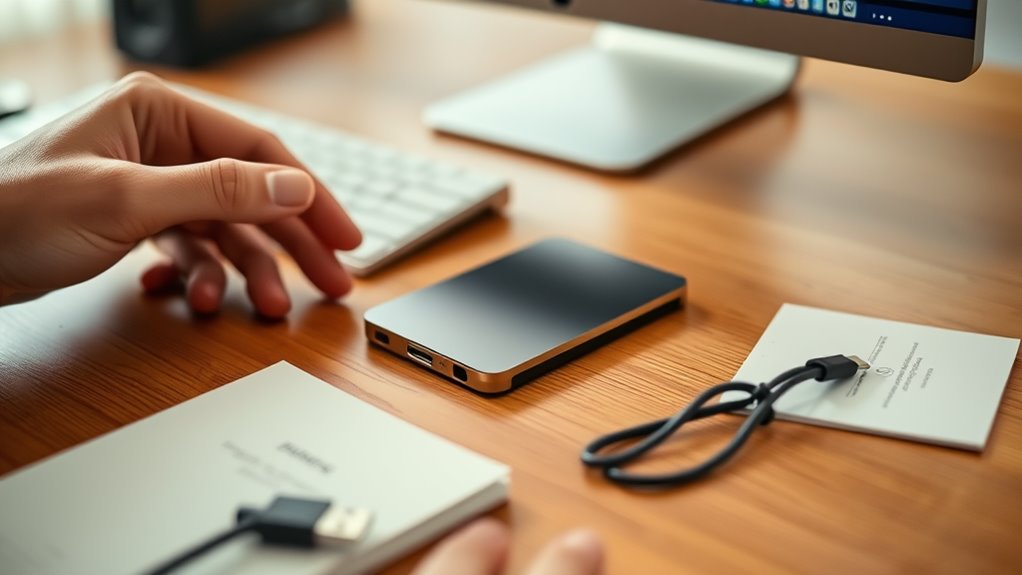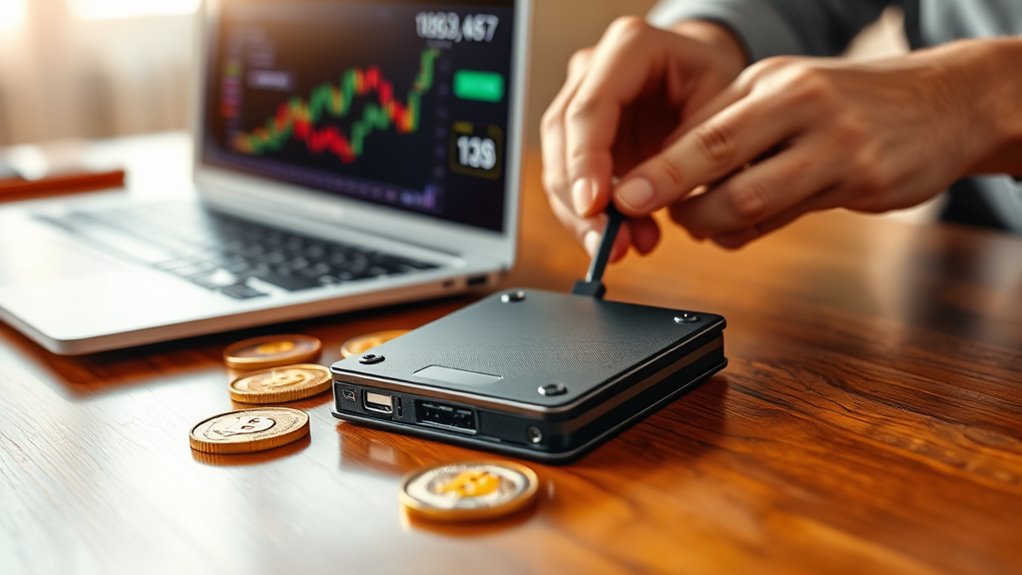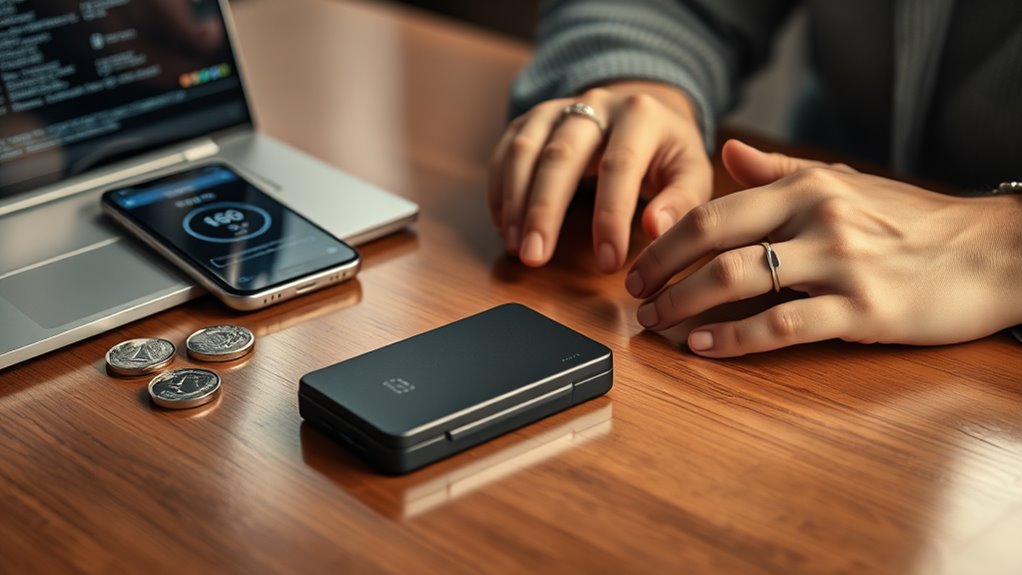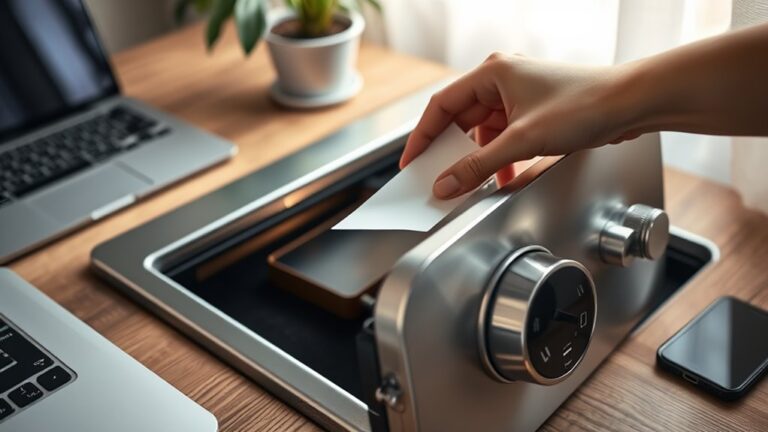
How to Use a Hardware Wallet for Maximum Security: The Essential Guide
Hardware wallets provide maximum cryptocurrency security by storing private keys offline. Users should purchase devices from authorized retailers, create strong PINs, and securely record recovery phrases on paper stored in multiple locations. When transacting, verify addresses character-by-character on the device screen and start with small test transactions. Regular firmware updates and physical device inspections maintain security integrity. Following these protocols protects digital assets from both online and physical threats.
Key Takeaways
- Purchase hardware wallets only from authorized vendors to avoid compromised devices and verify packaging integrity before setup.
- Generate and securely store your recovery seed phrase offline using durable materials and multiple copies in separate physical locations.
- Verify recipient addresses character-by-character on the hardware wallet’s screen before confirming any transaction.
- Regularly update firmware to patch security vulnerabilities and perform periodic physical inspections of your device.
- Use additional security measures like strong PINs, passphrases, and two-factor authentication for accessing your wallet companion applications.
What Is a Hardware Wallet and Why You Need One

Protectors of digital wealth, hardware wallets stand as the gold standard for cryptocurrency security in an increasingly vulnerable online landscape.
These physical devices, resembling USB drives, store cryptocurrencies offline in what’s known as “cold storage,” greatly reducing exposure to online threats.
Unlike software wallets, hardware wallets keep private keys—the critical codes that grant access to crypto funds—completely isolated from internet-connected devices.
This offline approach makes them virtually immune to hacking attempts, malware infections, and other digital vulnerabilities.
The device connects to computers only when transactions need authorization, and even then, private keys never leave the secure environment.
For cryptocurrency investors concerned about long-term security, hardware wallets offer unparalleled protection despite their higher cost and slightly more complex setup process. Additionally, using strong passwords and enabling multi-factor authentication further enhances the security of these devices.
Selecting the Right Hardware Wallet for Your Needs

With a solid understanding of hardware wallet fundamentals, selecting the ideal device becomes the next critical step in securing cryptocurrency assets. When evaluating options, focus on security features like robust encryption, two-factor authentication, and trusted displays that allow transaction verification directly on the device.
Consider compatibility aspects such as cryptocurrency and multi-chain support to guarantee the wallet accommodates your entire portfolio. Price ranges vary considerably, with higher costs typically reflecting advanced features and reputable brands. Always purchase from authorized resellers or manufacturers to avoid counterfeit products.
Never compromise on wallet compatibility—ensure it supports all your assets before investing.
Advanced features worth considering include secure chips, decentralized backups, and anti-tampering mechanisms. Third-party security audits and community feedback provide valuable insights into reliability. Additionally, ensure the wallet supports multi-factor authentication to further enhance security during transactions.
Ultimately, the right hardware wallet balances security requirements with your specific cryptocurrency holdings and budget constraints.
Step-by-Step Setup of Your Hardware Wallet

The proper setup of a hardware wallet forms the foundation of cryptocurrency security, requiring careful attention to several critical procedures. Users should begin by inspecting the device’s packaging for signs of tampering, followed by configuring a strong PIN that avoids predictable patterns.
The wallet will generate a recovery seed phrase that must be accurately recorded on paper and stored securely offline, never digitally.
- Verify the hardware wallet’s packaging integrity and authenticity before use
- Set up a strong PIN code, avoiding obvious sequences like birthdates
- Carefully record the seed phrase on physical media and store in a secure location
- Download official wallet software only from the manufacturer’s website
- Connect and sync the device, ensuring firmware updates are completed
- Consider using trusted key management systems to enhance your overall security.
Secure Storage of Your Recovery Phrase

After setting up a hardware wallet, safeguarding the recovery phrase becomes the most important aspect of cryptocurrency protection. This phrase must be stored offline to prevent digital theft and should be kept on durable materials for long-term preservation.
| Storage Method | Security Level | Durability |
|---|---|---|
| Paper Backup | Low-Medium | Poor |
| Steel Plates | High | Excellent |
| Split Storage | Very High | Good |
Experts recommend creating multiple copies of your recovery phrase and storing them in different secure locations. Never store this information digitally—not in password managers, cloud storage, or as digital photos. For enhanced security, consider advanced methods like Shamir’s Secret Sharing, which requires multiple parts to reconstruct the full phrase. Regular verification guarantees your backup remains accessible when needed. Additionally, ensure your recovery phrase is stored in a way that protects against common threats like theft or loss.
Connecting Your Wallet to Manage Cryptocurrency

Hardware wallets connect to devices through USB cables or wireless technologies like Bluetooth, requiring proper initialization to securely access digital assets.
Users must establish authentication methods such as PINs or passphrases during setup to protect their cryptocurrency holdings from unauthorized access.
The connection between hardware wallets and blockchain networks is facilitated by companion applications, which manage transaction data while ensuring private keys remain securely stored on the physical device.
Connection Methods Overview
Connecting a hardware wallet to manage cryptocurrency requires understanding several key interface options. Hardware wallets utilize a “crypto bridge” to link the device to the blockchain network while maintaining security.
These wallets are designed to keep private keys isolated from internet-connected devices, dramatically reducing vulnerability to remote attacks.
- Most hardware wallets connect to computers via USB or USB-C interfaces
- Transactions are created and signed within the wallet itself before being broadcast
- Physical security is paramount—attackers need physical possession to compromise the wallet
- Mobile connections may be available through Bluetooth or dedicated smartphone apps
- The wallet’s secure element chip guarantees private keys never leave the protected environment
The connection process is deliberately designed with multiple security layers, safeguarding your cryptocurrency remains protected even when interacting with potentially compromised computers. Additionally, understanding how crypto wallets function and their role in managing digital assets is essential for ensuring optimal security.
Securing Wallet Connections
Several critical security measures must be implemented when connecting hardware wallets to manage cryptocurrency assets. Users should only connect their devices to trusted computers with updated antivirus software to prevent malware attacks that could compromise sensitive information.
Avoiding public Wi-Fi networks is essential, as these connections may be monitored by malicious actors. When internet connectivity is necessary, using a VPN provides an additional layer of security.
Before connecting a hardware wallet, users should verify that their computer is free from viruses and spyware that could intercept transaction data.
Transaction details should always be verified on the hardware wallet’s screen, not just on the computer, as clipboard malware can alter recipient addresses.
Regular firmware updates from official manufacturer sources help protect against newly discovered security vulnerabilities. Additionally, implementing multi-factor authentication is crucial for further securing your crypto accounts against unauthorized access.
Safely Executing Transactions With Your Hardware Wallet

Cryptocurrency transactions through hardware wallets require careful verification of all details displayed on the device’s screen before signing.
Users should meticulously cross-check recipient addresses, comparing them character by character with the intended destination to prevent irreversible errors.
Starting with small test transactions before sending larger amounts provides an additional layer of security, confirming both the recipient’s address and the proper functioning of the hardware wallet.
Verify Before Signing
When conducting cryptocurrency transactions, users must carefully verify all details before signing and approving them on their hardware wallets.
Hardware wallets are designed to display important transaction information on their screens, allowing users to confirm the recipient address and amount before authorization. This verification process is vital for preventing losses due to address-swapping malware or other security threats.
- Hardware wallets display transaction details on their screens for manual verification
- Private keys remain offline during the signing process, enhancing security
- The verification step protects against address-swapping malware attacks
- Always check that the device is running genuine, up-to-date firmware
- Make certain the connection method (USB, Bluetooth, QR code) is secure and hasn’t been compromised
- Utilizing a VPN adds an extra layer of security by encrypting internet traffic, making it more challenging for cyberthieves to trace your transactions.
Cross-Check Recipient Addresses
Properly verifying recipient addresses represents one of the most essential steps in cryptocurrency transaction security, as even a single incorrect character can result in permanent loss of funds.
When using a hardware wallet, users should implement multiple verification methods rather than relying solely on visual inspection.
The safest approach involves comparing the recipient address displayed on your hardware wallet with the address shown on your connected computer. Additionally, utilizing QR code scanning eliminates manual entry errors.
Users should also familiarize themselves with blockchain-specific address formats to identify inconsistencies quickly.
Most hardware wallets display addresses on their screens for verification before transaction approval. This essential step should never be skipped, even for small transactions.
Remember that blockchains typically recognize invalid addresses, but cannot prevent transfers to valid but incorrect addresses. Furthermore, users should remain vigilant against phishing attacks, as these can compromise the integrity of transactions by redirecting funds to malicious addresses.
Small Test Transactions
Experienced cryptocurrency users almost always send a small test transaction before transferring large amounts with their hardware wallets. This practice helps verify that the sending and receiving processes work correctly while mitigating the risk of losing significant funds due to errors.
A successful test transaction builds confidence in the wallet’s functionality and reduces anxiety about larger transfers. Additionally, using cold storage for long-term holdings can enhance security during these test transactions.
- Always confirm your wallet’s software is up-to-date before conducting any test transactions
- Use secure networks rather than public Wi-Fi when performing cryptocurrency transfers
- Never share recovery seed phrases or transaction details with anyone, even during testing
- Disconnect your hardware wallet immediately after completing transactions to minimize exposure
- Schedule regular small test transactions to maintain familiarity with your wallet’s interface
Advanced Security Measures for Protecting Your Assets

Every hardware wallet offers numerous advanced security features that greatly improve the protection of cryptocurrency assets beyond basic storage capabilities. The cornerstone of this security is offline storage, keeping private keys isolated from internet-connected devices and safe from online threats.
Most devices incorporate secure elements with tamper-resistant technology, protecting against physical attacks and providing built-in countermeasures against known vulnerabilities. User authentication adds another essential layer, requiring physical confirmation of transactions through PINs or biometric verification.
For recovery purposes, hardware wallets generate seed phrases that serve as backups in case of device loss or damage. Additionally, popular options like hardware wallets are specifically designed to offer maximum security for your assets.
Advanced users can implement additional protections like multi-signature requirements or time-lock features, which delay transaction execution and create multiple verification checkpoints, considerably strengthening security against unauthorized access.
Troubleshooting Common Hardware Wallet Issues

While hardware wallets offer robust security features, users may encounter technical challenges that require troubleshooting. Most issues fall into specific categories that can be systematically addressed.
When facing problems, users should first identify the nature of the issue before attempting resolution.
- Forgotten PINs can be resolved by resetting the wallet using your seed phrase, though multiple incorrect attempts may lock or erase the device.
- Hardware malfunctions often require firmware updates or manufacturer assistance if physical damage is present.
- Connection problems typically stem from faulty cables or compatibility issues between wallet software and operating systems.
- Physical damage necessitates professional repair or data extraction using your seed phrase on a new device.
- Signing issues may occur with complex transactions containing numerous UTXOs, requiring patience or transaction splitting.
Upgrading and Maintaining Your Hardware Wallet

Regular maintenance and timely upgrades of hardware wallets are essential components of a thorough cryptocurrency security strategy. Manufacturers routinely release firmware updates that patch security vulnerabilities and add new features, making these updates vital for ideal protection.
| Maintenance Task | Recommended Frequency |
|---|---|
| Firmware Updates | When released by manufacturer |
| Seed Phrase Verification | Every 3-6 months |
| Physical Inspection | Monthly |
| Security Audit | Quarterly |
| Password/PIN Review | Every 6 months |
Before upgrading firmware, users should always back up their seed phrase as a precaution. Most devices support upgrades via USB connection or SD card, with the latter maintaining air-gapped security. After completing updates, verify that the device functions correctly by checking balances and testing a small transaction if possible.
Frequently Asked Questions
Can Hardware Wallets Be Used for Staking Cryptocurrency?
Hardware wallets can be used for staking cryptocurrency. They provide enhanced security by keeping private keys offline while supporting staking across multiple blockchains. Popular options include Ledger Nano X, Trezor, and ELLIPAL Titan.
What Happens if the Manufacturer Goes Out of Business?
Like a ship without a captain, a hardware wallet persists when its manufacturer sinks. Users retain access to funds via recovery seeds, though software updates cease, security risks increase, and support becomes community-dependent rather than official.
Can Hardware Wallets Be Used With Defi Platforms?
Hardware wallets can integrate with DeFi platforms through applications like MetaMask and WalletConnect. They provide secure interaction with DeFi services while keeping private keys offline, requiring physical transaction approval for enhanced security.
Are Hardware Wallets Compatible With NFT Marketplaces?
Hardware wallets are compatible with NFT marketplaces through third-party software interfaces. Users typically connect their hardware wallet to software wallets like MetaMask to securely interact with NFT platforms while maintaining offline key storage.
How Do Hardware Wallets Handle Blockchain Forks?
Hardware wallets protect users during blockchain forks by storing private keys offline and providing tools to securely claim new coins. They prevent replay attacks and typically require firmware updates to support forked cryptocurrencies.
Conclusion
Hardware wallets remain the gold standard in cryptocurrency security, creating an impenetrable fortress between digital assets and online threats. By following proper setup procedures, safeguarding recovery phrases, and implementing advanced security practices, investors can navigate the cryptocurrency landscape with confidence. Regular maintenance and staying informed about security updates guarantee long-term protection. In the ever-evolving world of digital assets, a hardware wallet isn’t just an option—it’s an essential investment in financial security.












